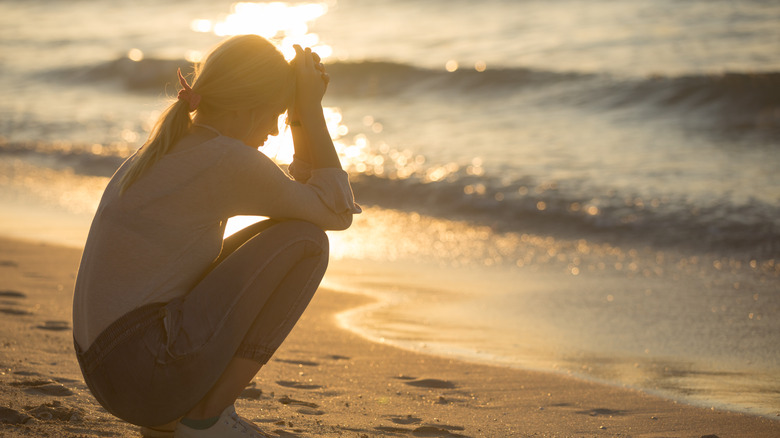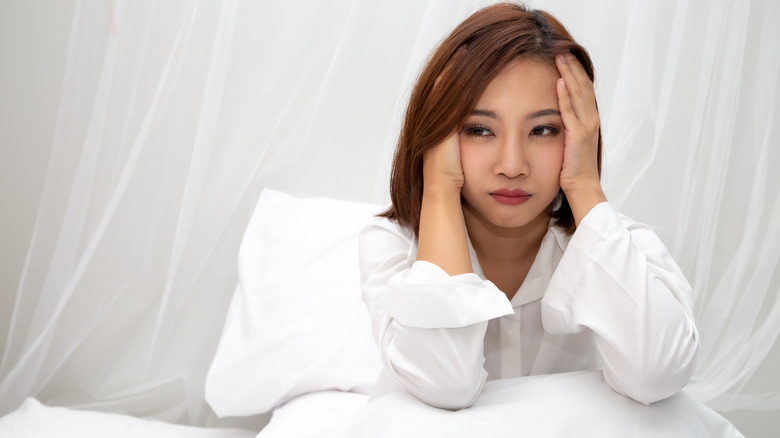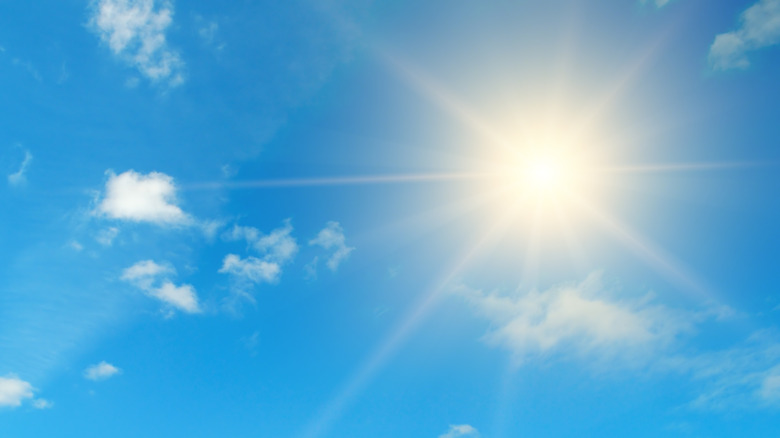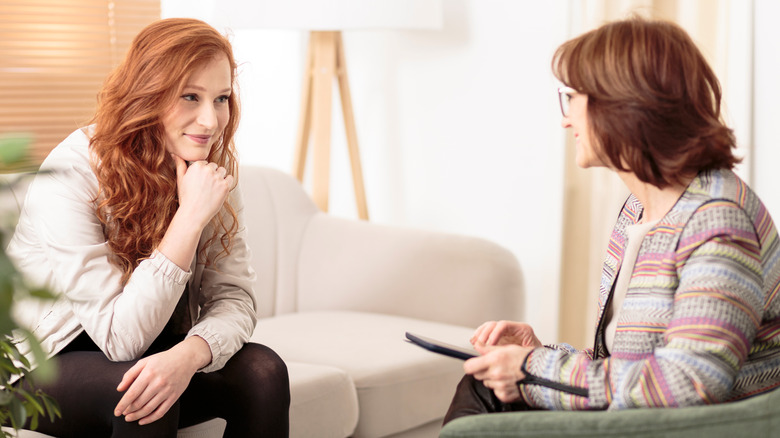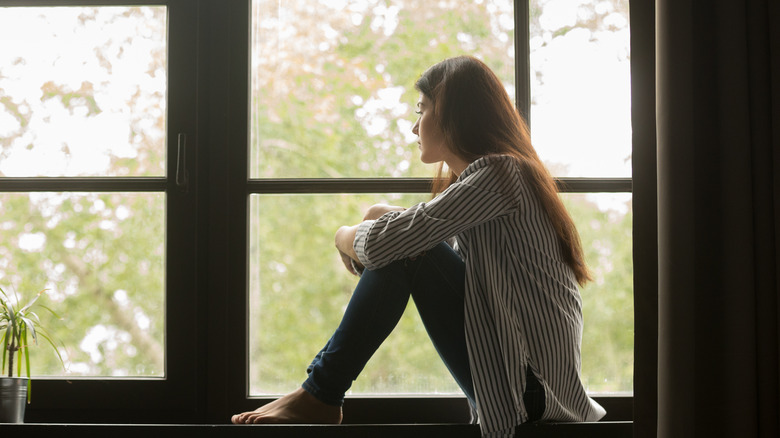What Is Reverse SAD?
It's warm, it's sunny, the birds are chirping, people are outside enjoying themselves — and you're cocooned in an air-conditioned room, miserable. It seems like an oxymoron — sad summer. But that's how it's been for you every year when the days lengthen and the temperature rises. You become blue when spring appears, and stay that way until fall, when you inexplicably return to "normal." Did you ever consider you might have reverse SAD?
SAD stands for seasonal affective disorder, although recently it's become known as Major Depressive Disorder with a Seasonal Pattern, according to Healthline. The more common form of SAD, and the one that most people are familiar with, strikes in the autumn. SAD sufferers fall into a funk when the weather turns cooler and remain stuck in depression throughout the winter. It's only when spring arrives that the blues lift and they feel like "themselves" again. The symptoms of winter SAD include daytime fatigue with oversleeping, lethargy, overeating, craving carbs, weight gain, depression, and hopelessness, according to the National Alliance on Mental Illness.
SAD in general affects 4 to 6 percent of the American population (per WebMD), with higher incidences among younger people, women, those who have a close relative with SAD or another form of depression, those who also have bipolar disorder, as well as those who live far north or south of the equator, according to the Mayo Clinic. (It's believed this is due to decreased sunlight in winter and longer days in summer.)
Symptoms of reverse SAD
About 10 percent of all SAD sufferers experience it during the summer, says WebMD. The risk factors for developing reverse SAD are the same as those for winter SAD, although it's unclear if living closer to or further away from the equator presents a higher risk. Some studies have shown that reverse SAD is more common than winter SAD in countries closer to the equator, possibly due to the increased heat and humidity.
The symptoms of reverse SAD, according to the National Institute of Mental Health, include those typical of major depressive disorder (such as feeling depressed most of the time and having difficulty concentrating) as well as symptoms like trouble sleeping or insomnia, poor appetite leading to weight loss, restlessness and agitation, and anxiety. One of the biggest contrasts between symptoms of winter SAD and reverse SAD is the mania experienced by those with reverse SAD versus the sluggishness in those with winter SAD, Norman Rosenthal, Georgetown University psychiatrist and professor, who first coined the term SAD, told Psychology Today. It's believed that the higher summer temperatures are to blame for the mania and agitation. In addition, some of those suffering with reverse SAD may experience temper flare-ups. That anger, according to Healthline, may also be due to the oppressive heat.
What causes reverse SAD?
Because winter SAD appears to be associated with too little sun during the dark winter (and is indeed treated by sitting in front of bulbs that simulate sunlight, per the Mayo Clinic), it makes sense that reverse SAD may be caused by too much sun. The above-average amount of sunshine may disrupt the body's production of melatonin, which is the hormone that controls the sleep-wake cycle, per Healthline. Melatonin follows a seasonal rhythm, having higher levels in the fall and winter and lower levels in the spring and summer, per the Society for Endocrinology. In winter SAD, overproduction of melatonin may increase sleepiness. Is it possible that a lower level of melatonin production, in spring and summer due to shorter nights and longer days, causes the agitation and restlessness of reverse SAD? Scientists don't know for sure — there are few studies specifically devoted to reverse SAD.
Another theory for reverse SAD has to do with the body's circadian rhythm — staying up later in summer may affect this natural rhythm, per Psychology Today, as can the disrupted schedule (vacation travel, no school) that normally occurs in summertime, says WebMD.
Treatments for reverse SAD
As SAD is a type of major depressive disorder, some treatments for it are the same as those for year-round depression. Others are more specific to SAD. According to the National Institute of Mental Health and Healthline, they include:
-
Psychotherapy. A specific cognitive behavioral therapy adapted for people with SAD, called CBT-SAD, helps patients engage in activities to combat the loss of interest experienced with SAD. "Talk therapy" can also help patients manage the feelings that come with missing out on outdoor summer activities with friends.
-
Medications. Antidepressants in the SSRI class can be used to treat SAD, as can another type of antidepressant, bupropion, by helping significantly with mood.
-
Vitamin D. Because vitamin D appears to play a role in serotonin levels, and many people with SAD have a vitamin D deficiency, a supplement may improve symptoms. However, the results of studies exploring the effect of vitamin D on SAD have been mixed.
-
Cool dark rooms. Since reverse SAD is opposite of winter SAD, it's believed that less time spent in bright, hot conditions may relieve symptoms. Instead of basking in light therapy, those with reverse SAD might do well to seek out dark environments whenever possible, although the specifics of this "treatment" are unknown.
-
Sleep and exercise. Resist the temptation to stay up late on summer nights, which can contribute to reverse SAD. Not getting adequate sleep is a trigger for depression (per WebMD). And be sure to keep up with exercise. Many studies have shown that regular physical activity helps ward off depression.
Coming to terms with reverse SAD
It may seem antisocial to resist participating in sunny outdoor activities, and odd to hate summer when everyone else is having a months-long party, but reverse SAD is a subset of major depression and should be acknowledged as such and treated if necessary. Left untreated, like other types of depression, it can worsen and lead to complications such as work problems, substance abuse, or suicidal thoughts, according to the Mayo Clinic.
Even if the intensity of your reverse SAD never rises to that level, it helps not to blame yourself for being "different" or "weird." Stop asking yourself, "What's wrong with me?" And stop worrying about how you're supposed to feel now that the calendar says summer.
"So much of our misery grows out of the gap between where we are and where we think we ought to be," Ian Cook, M.D., the director of the Depression Research Program at UCLA, told WebMD. So get professional help if you need it, or just spend a lot of time in cool, dark rooms for the time being. Before you know it, fall will be here.

